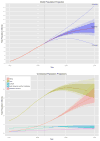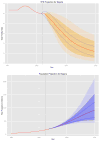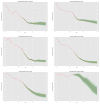World population stabilization unlikely this century - PubMed (original) (raw)
. 2014 Oct 10;346(6206):234-7.
doi: 10.1126/science.1257469. Epub 2014 Sep 18.
Adrian E Raftery 2, Hana Sevčíková 3, Nan Li 4, Danan Gu 4, Thomas Spoorenberg 4, Leontine Alkema 5, Bailey K Fosdick 6, Jennifer Chunn 7, Nevena Lalic 8, Guiomar Bay 9, Thomas Buettner 10, Gerhard K Heilig 10, John Wilmoth 4
Affiliations
- PMID: 25301627
- PMCID: PMC4230924
- DOI: 10.1126/science.1257469
World population stabilization unlikely this century
Patrick Gerland et al. Science. 2014.
Abstract
The United Nations (UN) recently released population projections based on data until 2012 and a Bayesian probabilistic methodology. Analysis of these data reveals that, contrary to previous literature, the world population is unlikely to stop growing this century. There is an 80% probability that world population, now 7.2 billion people, will increase to between 9.6 billion and 12.3 billion in 2100. This uncertainty is much smaller than the range from the traditional UN high and low variants. Much of the increase is expected to happen in Africa, in part due to higher fertility rates and a recent slowdown in the pace of fertility decline. Also, the ratio of working-age people to older people is likely to decline substantially in all countries, even those that currently have young populations.
Copyright © 2014, American Association for the Advancement of Science.
Figures
Figure 1
(a) Top: UN 2012 world population projection (solid red line), with 80% prediction interval (dark shaded area), 95% prediction interval (light shaded area), and the traditional UN high and low variants (dashed blue lines). (b) Bottom: UN 2012 population projections by continent.
Figure 2
UN 2012 Projection of (a) total fertility rate (top) and (b) total population (bottom) for Nigeria (solid red line), with 80% prediction interval (dark shaded area), 95% prediction interval (light shaded area), and traditional UN high and low variants (dashed blue lines).
Figure 3
UN Projections of potential support ratios, equal to the number of people aged 20–64 divided by the number of people aged 65 or over (solid red line), with 80% prediction interval (dark shaded area) and 95% prediction interval (light shaded area).
Comment in
- Economics. Adjusting to the fertility bust.
Smeeding TM. Smeeding TM. Science. 2014 Oct 10;346(6206):163-4. doi: 10.1126/science.1260504. Science. 2014. PMID: 25301602 Free PMC article. No abstract available. - Population growth: peak probability.
Lutz W, Butz W, K C S, Sanderson W, Scherbov S. Lutz W, et al. Science. 2014 Oct 31;346(6209):561. doi: 10.1126/science.346.6209.561-a. Science. 2014. PMID: 25359958 No abstract available. - Population growth: limits of food supply.
Holt RR. Holt RR. Science. 2014 Oct 31;346(6209):561. doi: 10.1126/science.346.6209.561-b. Science. 2014. PMID: 25359959 No abstract available. - Sustainability: A meaty issue.
Heffernan O. Heffernan O. Nature. 2017 Apr 26;544(7651):S18-S20. doi: 10.1038/544S18a. Nature. 2017. PMID: 28445446 No abstract available.
Similar articles
- Long-range global population projections, as assessed in 1980.
United Nations. Department of International Economic and Social Affairs. Population Division. United Nations. Department of International Economic and Social Affairs. Population Division. Popul Bull UN. 1982;(14):17-30. Popul Bull UN. 1982. PMID: 12264846 - [World demographic perspectives].
Tabah L. Tabah L. Tiers Monde. 1983 Apr-Jun;24(94):305-24. Tiers Monde. 1983. PMID: 12312442 French. - Dimensions of global population projections: what do we know about future population trends and structures?
Lutz W, K C S. Lutz W, et al. Philos Trans R Soc Lond B Biol Sci. 2010 Sep 27;365(1554):2779-91. doi: 10.1098/rstb.2010.0133. Philos Trans R Soc Lond B Biol Sci. 2010. PMID: 20713384 Free PMC article. Review. - Population projections for Mongolia: 1989-2019.
Neupert RF. Neupert RF. Asia Pac Popul J. 1992 Dec;7(4):61-80. Asia Pac Popul J. 1992. PMID: 12317941 - Projecting the impact of AIDS on mortality.
Stover J, Way P. Stover J, et al. AIDS. 1998;12 Suppl 1:S29-39. AIDS. 1998. PMID: 9677187 Review.
Cited by
- Hydrothermal Carbonization of Biomass for Electrochemical Energy Storage: Parameters, Mechanisms, Electrochemical Performance, and the Incorporation of Transition Metal Dichalcogenide Nanoparticles.
Prieto M, Yue H, Brun N, Ellis GJ, Naffakh M, Shuttleworth PS. Prieto M, et al. Polymers (Basel). 2024 Sep 18;16(18):2633. doi: 10.3390/polym16182633. Polymers (Basel). 2024. PMID: 39339098 Free PMC article. Review. - Relationship between triglyceride-glucose index and cognitive function among community-dwelling older adults: a population-based cohort study.
Bai W, An S, Jia H, Xu J, Qin L. Bai W, et al. Front Endocrinol (Lausanne). 2024 Jul 22;15:1398235. doi: 10.3389/fendo.2024.1398235. eCollection 2024. Front Endocrinol (Lausanne). 2024. PMID: 39104819 Free PMC article. - Biochemical and molecular profiling of induced high yielding M3 mutant lines of two Trigonella species: Insights into improved yield potential.
Naaz N, Choudhary S, Hasan N, Sharma N, Al Aboud NM, Shehata WF. Naaz N, et al. PLoS One. 2024 Jul 29;19(7):e0305691. doi: 10.1371/journal.pone.0305691. eCollection 2024. PLoS One. 2024. PMID: 39074097 Free PMC article. - CRISPR/Cas9 genome editing of potato _St_DMR6-1 results in plants less affected by different stress conditions.
Karlsson M, Kieu NP, Lenman M, Marttila S, Resjö S, Zahid MA, Andreasson E. Karlsson M, et al. Hortic Res. 2024 May 6;11(7):uhae130. doi: 10.1093/hr/uhae130. eCollection 2024 Jul. Hortic Res. 2024. PMID: 38974188 Free PMC article. - Planetary Health Diet Index and risk of total and cause-specific mortality in three prospective cohorts.
Bui LP, Pham TT, Wang F, Chai B, Sun Q, Hu FB, Lee KH, Guasch-Ferre M, Willett WC. Bui LP, et al. Am J Clin Nutr. 2024 Jul;120(1):80-91. doi: 10.1016/j.ajcnut.2024.03.019. Epub 2024 Jun 10. Am J Clin Nutr. 2024. PMID: 38960579
References
- UNAIDS. Global Report: UNAIDS Report on the Global AIDS Epidemic 2013. UNAIDS; Geneva, Switzerland: 2013.
- United Nations. World Population Prospects: The 2012 Revision. Population Division, Dept. of Economic and Social Affairs, United Nations; New York, NY: 2013.
- Lee RD, Tuljapurkar S. Journal of the American Statistical Association. 1994;89:1175. - PubMed
- National Research Council. Beyond Six Billion: Forecasting the World’s Population. National Academy Press; Washington, D.C: 2000.
Publication types
MeSH terms
LinkOut - more resources
Full Text Sources
Other Literature Sources


